The Black-billed Cuckoo (Coccyzus erythropthalmus) is a fascinating avian species renowned for its distinctive appearance and intriguing behaviors.
Belonging to the Cuculidae family, this medium-sized cuckoo is primarily found in North America, inhabiting a variety of wooded environments such as deciduous and mixed forests.
Recognized by its striking black bill and contrasting red eye ring, the Black-billed Cuckoo possesses cryptic plumage that aids in blending seamlessly with its surroundings.
Known for its secretive nature, this bird is often challenging to spot despite its widespread distribution.
Renowned for its distinct vocalizations, the Black-billed Cuckoo’s song resonates with a series of soft, hollow “coo-coo-coo” notes, adding a melodic touch to its woodland habitat.
As an insectivorous species, its diet primarily consists of hairy caterpillars, making it a valuable contributor to pest control in the ecosystems it inhabits.
Studying the Black-billed Cuckoo provides valuable insights into the intricate dynamics of avian ecology and the delicate balance within their ecosystems.
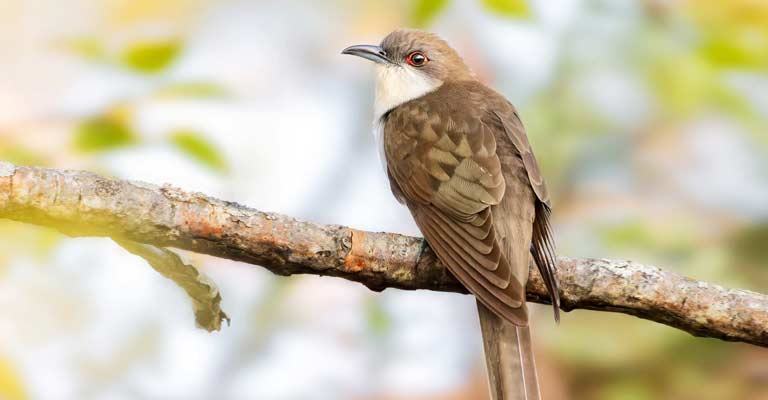
How to identify Black-billed Cuckoo?
Identifying the Black-billed Cuckoo (Coccyzus erythropthalmus) can be a rewarding but challenging endeavor for bird enthusiasts due to its elusive nature and cryptic plumage.
Here are eight key points to consider when identifying this specific bird:
Distinctive Black Bill and Red Eye Ring
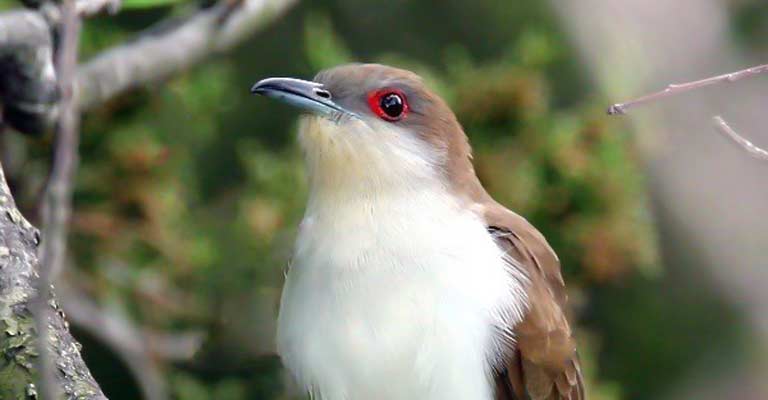
The most prominent feature of the Black-billed Cuckoo is its striking black bill, which stands out prominently against its predominantly brown and olive plumage.
Additionally, the bird sports a distinctive red eye ring, providing a unique contrast to its facial features.
Cryptic Plumage for Camouflage
The Black-billed Cuckoo possesses cryptic plumage that serves as an effective camouflage in its woodland habitat.
The upperparts are typically brown and olive, while the underparts are paler with a white or buff color. This helps the bird blend seamlessly with the foliage, making it challenging to spot.
Medium-sized and Slender Build
In terms of size, the Black-billed Cuckoo is medium-sized, measuring around 11 to 12 inches in length. Its slender build contributes to its agile nature, allowing it to navigate through dense vegetation with ease.
Long Tail with White Tips
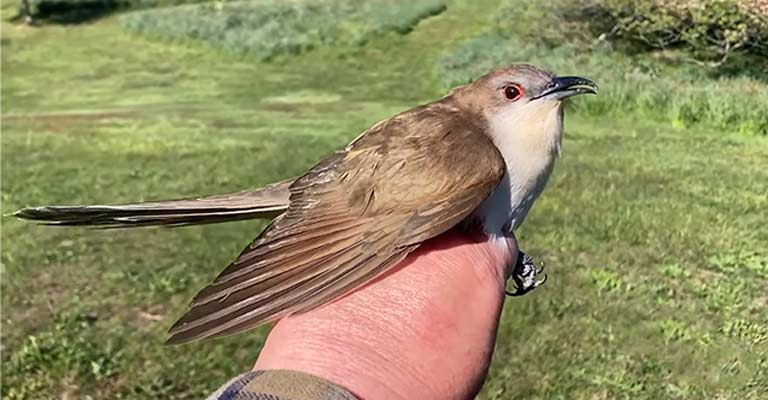
One of the distinctive features aiding in identification is the long tail of the Black-billed Cuckoo, featuring white tips on the outer feathers.
This characteristic becomes evident when the bird is in flight or when it fans its tail, providing observers with a valuable visual cue.
Secretive Behavior and Elusive Nature
The Black-billed Cuckoo is known for its secretive behavior, often staying hidden within the canopy of trees.
It can be challenging to spot due to its preference for dense vegetation, making patient observation and a keen eye essential for identification.
Unique Vocalizations
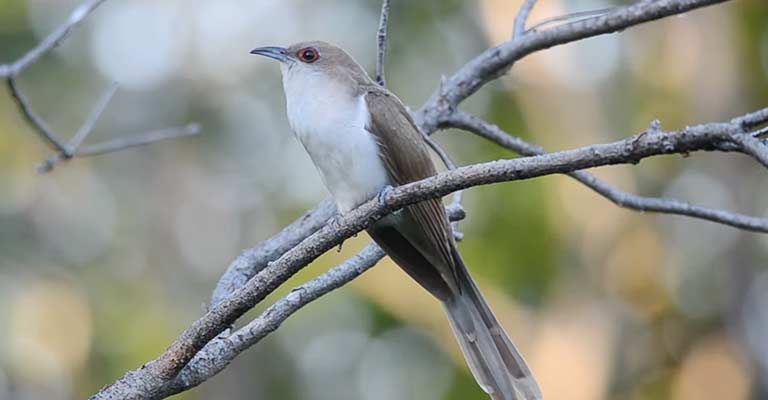
Listening to the unique vocalizations of the Black-billed Cuckoo can be a key identifier. Its song is a series of soft, hollow “coo-coo-coo” notes, distinctive from the calls of other birds in its habitat.
Familiarizing oneself with these vocalizations can greatly aid in locating and identifying the species.
Woodland Habitat Preference
Understanding the bird’s habitat preferences is crucial. The Black-billed Cuckoo is primarily found in wooded environments, including deciduous and mixed forests.
Observers are more likely to encounter this species in areas with a dense canopy and ample foliage.
Insectivorous Feeding
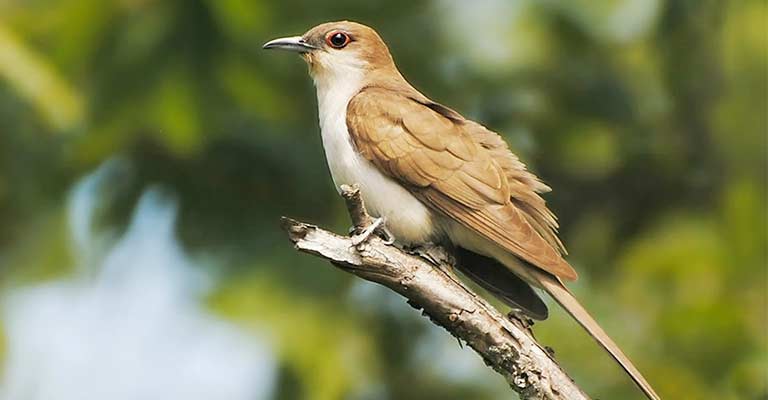
The Black-billed Cuckoo’s insectivorous diet can be indicative of its presence. It is known to feed on hairy caterpillars, actively searching for these in the treetops.
Observing its foraging behavior and dietary preferences can contribute to a more comprehensive identification.
Identifying the Black-billed Cuckoo requires a combination of keen observation skills, an understanding of its distinctive features, and familiarity with its habitat and behaviors.
Patience and a discerning eye are essential when attempting to spot this elusive bird in its natural environment.
Taxonomical details of Black-billed Cuckoo
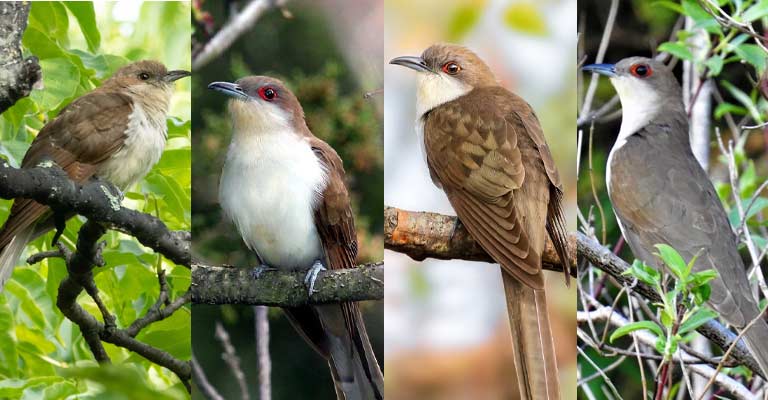
Here is a table summarizing everything about the taxonomy details of the Black-billed Cuckoo:
| Taxonomic Rank | Classification |
| Domain | Eukaryota |
| Kingdom | Animalia |
| Phylum | Chordata |
| Class | Aves |
| Order | Cuculiformes |
| Family | Cuculidae |
| Genus | Coccyzus |
| Species | C. erythropthalmus |
The Black-billed Cuckoo (Coccyzus erythropthalmus) belongs to the avian family Cuculidae, which encompasses cuckoos and roadrunners.
This medium-sized bird falls under the order Cuculiformes, sharing this taxonomic classification with other diverse species characterized by zygodactyl feet and distinct vocalizations.
The genus Coccyzus further categorizes the Black-billed Cuckoo among North American cuckoos. Its specific epithet, “erythropthalmus,” highlights the distinctive red eye ring.
As a member of the Aves class, the Black-billed Cuckoo exemplifies the avian diversity shaped by millions of years of evolution, adapting to various habitats and ecological niches within its taxonomic lineage.
Common Food of Black-billed Cuckoo
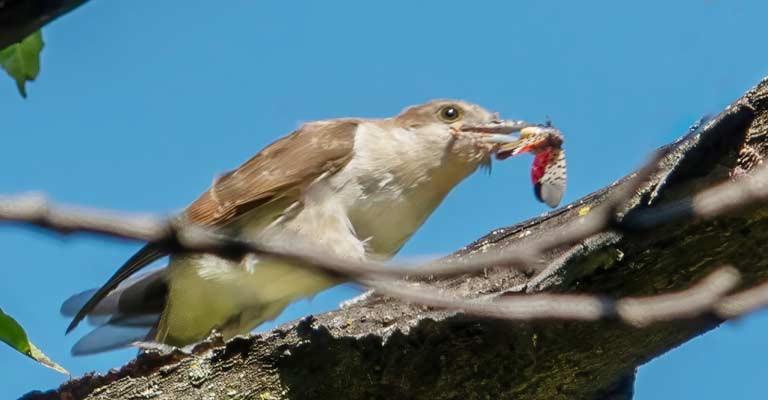
The Black-billed Cuckoo (Coccyzus erythropthalmus) is an insectivorous bird with a specialized diet that primarily consists of a variety of arthropods.
Its feeding habits play a crucial role in maintaining ecological balance, especially in wooded environments. The common foods of the Black-billed Cuckoo include:
- Hairy Caterpillars: A significant portion of the Black-billed Cuckoo’s diet comprises hairy caterpillars, which are often considered a pest to vegetation. The bird’s consumption of these caterpillars aids in natural pest control.
- Insects and Spiders: The diet extends to various insects, including beetles, grasshoppers, moths, and spiders. The bird’s agile foraging techniques allow it to capture these invertebrates from the treetops.
- Other Arthropods: Black-billed Cuckoos may also consume a range of other arthropods, such as crickets and centipedes, contributing to the overall diversity in their diet.
This insect-centric feeding strategy underscores the bird’s ecological significance, as it actively participates in the regulation of insect populations, showcasing its role as a valuable contributor to the health of the ecosystems it inhabits.
Hunting Habit of Black-billed Cuckoo
The Black-billed Cuckoo (Coccyzus erythropthalmus) exhibits distinctive hunting habits shaped by its insectivorous diet.
Employing a patient and methodical approach, these birds navigate the dense foliage of wooded environments in search of prey.
Known for their adept foraging skills, Black-billed Cuckoos primarily hunt for hairy caterpillars, insects, and spiders. Their slender build and long tail aid in maneuvering through the treetops.
Utilizing a sit-and-wait strategy, they perch in strategic locations, keenly observing their surroundings. When prey is spotted, the cuckoo swiftly captures it with a swift, precise motion.
This hunting behavior not only sustains the bird’s nutritional needs but also plays a vital ecological role in regulating insect populations, contributing to the overall health and balance of their habitat.
Black-billed Cuckoo Life History
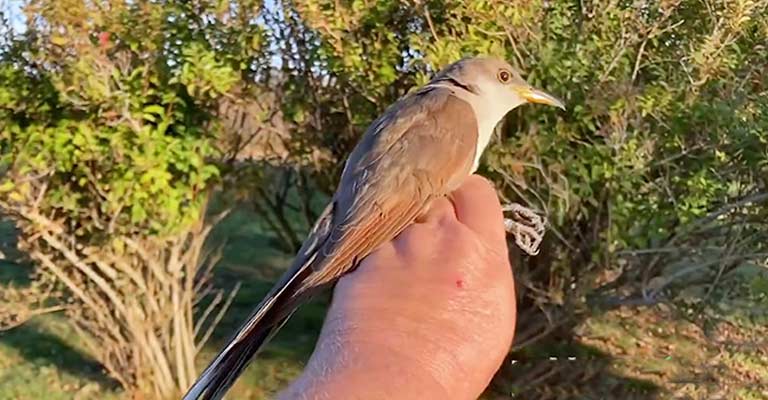
The Black-billed Cuckoo (Coccyzus erythropthalmus) unfolds a captivating life history marked by its elusive nature, unique adaptations, and ecological significance.
This medium-sized cuckoo, residing in the Cuculidae family, has a distinctive life cycle shaped by its insectivorous diet, specialized habitat preferences, and vital contributions to ecosystem health.
Food
The Black-billed Cuckoo is an insect specialist, primarily feeding on hairy caterpillars, insects, spiders, and various arthropods.
Its role in natural pest control, particularly about caterpillars, underscores its ecological importance.
Habitat
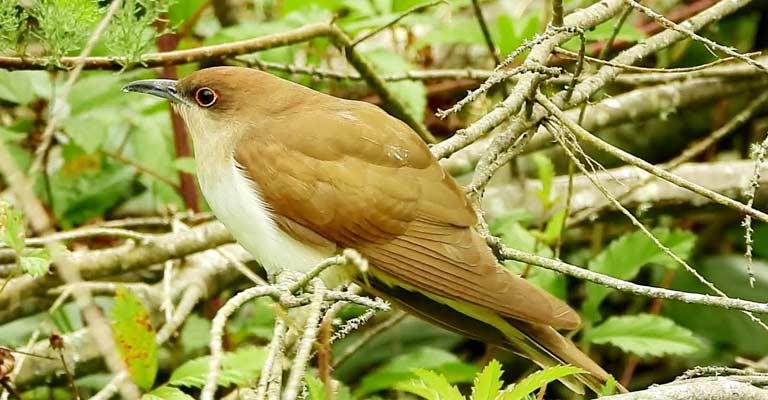
This species thrives in wooded environments, including deciduous and mixed forests, where its cryptic plumage aids in blending seamlessly with the foliage.
Its preference for dense vegetation and a variety of insects aligns with its chosen habitat.
Range Map
The Black-billed Cuckoo exhibits a broad range across North America during its breeding season, extending from the eastern parts of the United States and Canada to portions of Mexico.
A range map visually represents the distribution of this species, highlighting key areas for observation and conservation efforts.
Nesting
Nesting behavior involves the construction of a loose, twig-based platform typically situated in the upper canopy of trees. The female lays a clutch of pale blue-green eggs, and both parents share incubation duties.
Here is a table focusing all the necessary info regarding the Black-billed cuckoo’s nesting habit:
| Nesting Parameter | Information |
| Clutch Size | 2 to 4 eggs |
| Number of Broods | Usually one brood per breeding season |
| Egg Length | Approximately 0.9 to 1.0 inches (2.3 to 2.5 cm) |
| Egg Width | Approximately 0.7 to 0.8 inches (1.8 to 2.0 cm) |
| Incubation Period | About 11 to 12 days, both parents share incubation |
| Nestling Period | Approximately 8 to 12 days |
| Egg Description | Pale blue-green eggs with a smooth surface |
| Nest Type | Loose, twig-based platform in the upper canopy |
| Nest Location | Positioned in the upper branches of trees |
Breeding
The breeding season sees an increase in vocalizations as the birds establish territories and courtship rituals. The male’s distinctive “coo-coo-coo” song contributes to the species’ reproductive success.
Diseases
While the Black-billed Cuckoo may face threats from avian diseases, specific illnesses affecting this species can vary. Common avian ailments, such as respiratory infections or parasites, may impact individuals.
Treatment
Treatment protocols for avian diseases in the Black-billed Cuckoo may involve veterinary intervention, supportive care, and, if applicable, addressing environmental factors contributing to illness.
Conservation efforts may also play a role in mitigating disease risks.
Conservation
Conservation measures for the Black-billed Cuckoo focus on preserving and restoring suitable wooded habitats, especially those prone to disturbance.
Recognizing the bird’s role in insect control emphasizes the broader ecological significance of its conservation. Habitat protection, along with monitoring and research initiatives, contributes to ensuring the continued well-being of this enigmatic species.
5 Fun Facts About Black-billed Cuckoo
The Black-billed Cuckoo (Coccyzus erythropthalmus) is an intriguing avian species with a range of captivating features that set it apart in the bird kingdom. Here are five fun facts about this enigmatic bird:
- Mimicry Mastery: Black-billed Cuckoos are known for their exceptional mimicry skills, imitating the calls of other bird species to communicate and establish territories.
- Cryptic Camouflage: Their cryptic plumage not only helps them blend seamlessly into the foliage but also makes them challenging to spot, earning them the nickname “Rain Crow” due to their elusive nature.
- Long-Distance Migrant: During the winter months, these cuckoos embark on an impressive long-distance migration, traveling from their North American breeding grounds to Central and South America.
- Unique Nesting Habits: Black-billed Cuckoos often lay their eggs in the nests of other birds, a behavior known as brood parasitism. This adaptation allows them to allocate more energy to foraging and less to parental care.
- Nocturnal Feeders: Displaying a nocturnal feeding behavior, these cuckoos often forage during the night, actively seeking out their preferred prey of caterpillars and insects while others sleep.
Wrapping Up
The Black-billed Cuckoo (Coccyzus erythropthalmus) emerges as a captivating avian species, weaving its significance into the intricate tapestry of North American ecosystems.
Its elusive nature, marked by cryptic plumage and mimicry mastery, adds an air of mystery to the woodlands it inhabits.
From the distinctive “coo-coo-coo” calls echoing through the trees to the fascinating brood parasitism exhibited in their nesting habits, these birds showcase unique adaptations that enrich our understanding of avian life.
Beyond their aesthetic appeal, the Black-billed Cuckoo plays a vital role in ecological balance, particularly as a natural pest controller, preying on hairy caterpillars and insects.
As a long-distance migrant, its journey to Central and South America underscores the interconnectedness of avian habitats across continents.
Appreciating the conservation needs of this species becomes paramount, emphasizing the importance of preserving wooded habitats and addressing potential threats.
Through ongoing research, awareness, and habitat protection efforts, we can contribute to ensuring the continued existence and well-being of this fascinating bird, allowing future generations to marvel at the wonders of the Black-billed Cuckoo in the wild.